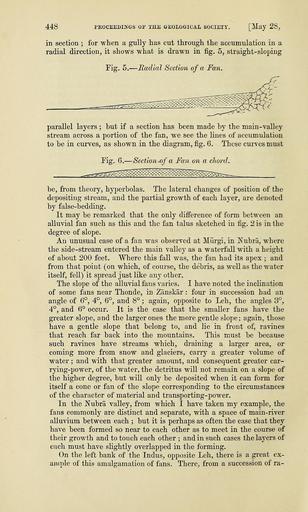MAKE A MEME
View Large Image

| View Original: | The_Quarterly_journal_of_the_Geological_Society_of_London_(13369010495).jpg (1917x3186) | |||
| Download: | Original | Medium | Small | Thumb |
| Courtesy of: | commons.wikimedia.org | More Like This | ||
| Keywords: The Quarterly journal of the Geological Society of London (13369010495).jpg 448 PROCEEDINGS OE THE GEOLOGICAL SOCIETY ilay 28 <br> in section ; for when a gully has cut through the accumulation in a <br> radial direction it shows what is drawn in fig 5 straight-sloping <br> Fig 5 ” Radial Section of a Fan <br> parallel layers ; but if a section has been made by the main-valley <br> stream across a portion of the fan we see the lines of accumulation <br> to be in curves as shown in the diagram fig 6 These curves must <br> Fig 6 ” Section -of a Fan on a clwrcl <br> be from theory hyperbolas The lateral changes of position of the <br> depositing stream and the partial growth of each layer are denoted <br> by false-bedding <br> It may be remarked that the only difference of form between an <br> alluvial fan such as this and the fan talus sketched in fig 2 is in the <br> degree of slope <br> An unusual case of a fan was observed at Murgi in S ubra where <br> the side-stream entered the main valley as a waterfall with a height <br> of about 200 feet Where this fall was the fan had its apex ; and <br> from that point on which of course the debris as well as the water <br> itself fell it spread just like any other <br> The slope of the alluvial fans varies I have noted the inclination <br> of some fans near Thonde in Zanskar four in succession had an <br> angle of 6° 4° 6° and 8° ; again opposite to Leh the angles 3° <br> 4° and 6° occur It is the case that the smaller fans have the <br> greater slope and the larger ones the more gentle slope; again those <br> have a gentle slope that belong to and lie in front of ravines <br> that reach far back into the mountains This must be because <br> such ravines have streams which draining a larger area or <br> coming more from snow and glaciers carry a greater volume of <br> water ; and with that greater amount and consequent greater car- <br> rying-power of the water the detritus will not remain on a slope of <br> the higher degree but will only be deposited when it can form for <br> itself a cone or fan of the slope corresponding to the circumstances <br> of the character of material and transporting-power <br> In the Nubra valley from which I have taken my example the <br> fans commonly are distinct and separate with a space of main-river <br> alluvium between each ; but it is perhaps as often the case that they <br> have been formed so near to each other as to meet in the course of <br> their growth and to touch each other ; and in such cases the layers of <br> each must have slightly overlapped in the forming <br> On the left bank of the Indus opposite Leh there is a great ex- <br> ample of this amalgamation of fans There from a succession of ra- 39051386 120601 51125 Page 448 Text v 29 http //www biodiversitylibrary org/page/39051386 1873 Geological Society of London Biodiversity Heritage Library The Quarterly journal of the Geological Society of London v 29 1873 Geology Periodicals Smithsonian Libraries bhl page 39051386 dc identifier http //biodiversitylibrary org/page/39051386 smithsonian libraries Information field Flickr posted date ISOdate 2014-03-24 Check categories 2015 August 26 CC-BY-2 0 BioDivLibrary https //flickr com/photos/61021753 N02/13369010495 2015-08-26 10 53 27 cc-by-2 0 PD-old-70-1923 The Quarterly journal of the Geological Society of London 1873 Photos uploaded from Flickr by Fæ using a script | ||||